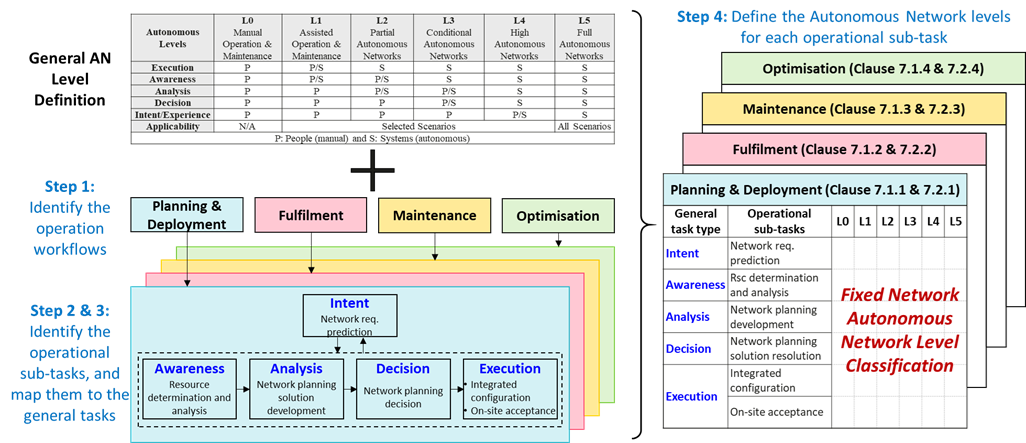Driving the Optical Networks towards Higher Autonomous Network Levels
In April 2025, ETSI published a new Group Report (GR), ETSI GR F5G 019 (Fifth Generation Fixed Network (F5G); Fixed Network Autonomous Network level definition and evaluation), which was developed in the ETSI ISG F5G.
This document provides an evaluation basis for measuring the Autonomous Network levels (from L0 to L5) of a Fixed Network (including Optical Transport Network and the Access and Residential Networks) along with its components and workflows, and defines the evaluation methodology to score the level of a specific system in a Fixed Network.
With the rapid development of Artificial Intelligence (AI) technologies, the way of managing and operating a telecommunication network becomes more and more intelligent. In TM Forum, a general Autonomous Network level classification system is defined, which provides a common understanding of how intelligent a general network is. In such a system, the higher the level of Autonomous Network, the fewer are the manual workflows involved.
Based on the general Autonomous Network level classification system, ETSI GR F5G 019 further defines the classification and evaluation of the Autonomous Network levels for the fixed optical network (including Optical Transport Network and the Access and Residential Networks) management, control and operation.
Specifically, this document firstly identifies the fixed network operation workflows (including the planning and deployment, fulfilment, maintenance, and optimization) and their operational sub-tasks, then maps these operational sub-tasks to different types of general tasks (intent translation, awareness, analysis, decision and execution) in the general workflow, and then defines the detailed Autonomous Network levels for each operational sub-task, based on the general level evaluation criteria.
This document also provides the general method of how to measure the fixed network Autonomous network levels, based on the Autonomous Network level classification defined in this document.

Methodology to define the fixed network Autonomous Network levels
This document is beneficial to the operators in the development of intelligent optical networks:
- It provides the industry with an evaluation consensus basis on measuring the autonomous capability of a fixed optical network.
- It provides guidance to the industry to develop roadmaps, phased objectives, relevant strategies and plans towards an intelligent fixed optical network.
- It provides decision-making assistance to network operators, vendors and other industry participants in technology choice and product planning on the aspect of network intelligence.
As the Rapporteur and one of the contributors of this document, MTN recognizes the importance of Autonomous Networks, and is formulating their strategies, technologies, and implementation roadmaps to achieve the Autonomous Network L4 objectives, according to the level definition in this document. MTN has been investing in Autonomous Networks to automate the optical network operations and gain real-time visibility, and to enhance their customers' experiences. MTN is now concentrating on developing the Autonomous Networks L4 blueprint, which will identify high-value scenarios (such as quality assurance in in transport network, experience awareness automatic diagnosis in home Broadband), and specify the evaluation criteria, effectiveness targets, processes, and architecture for Autonomous Networks L4.
New technologies and standards are encouraged in ISG F5G, to promote the evolution of optical networks towards higher level Autonomous Networks.

